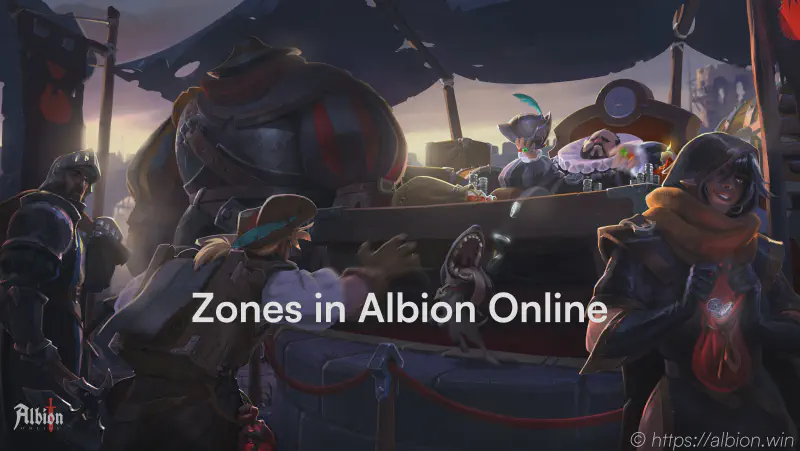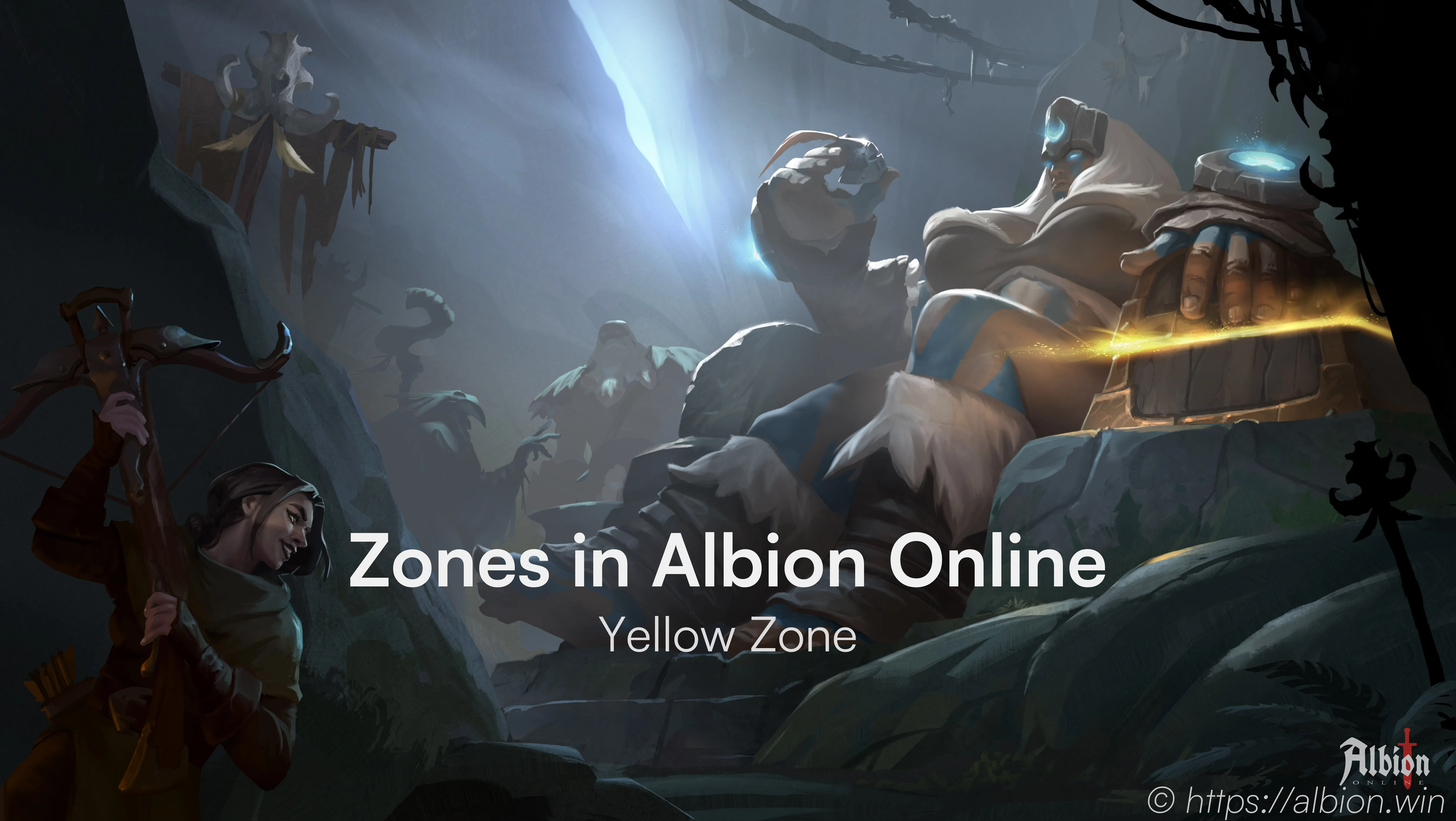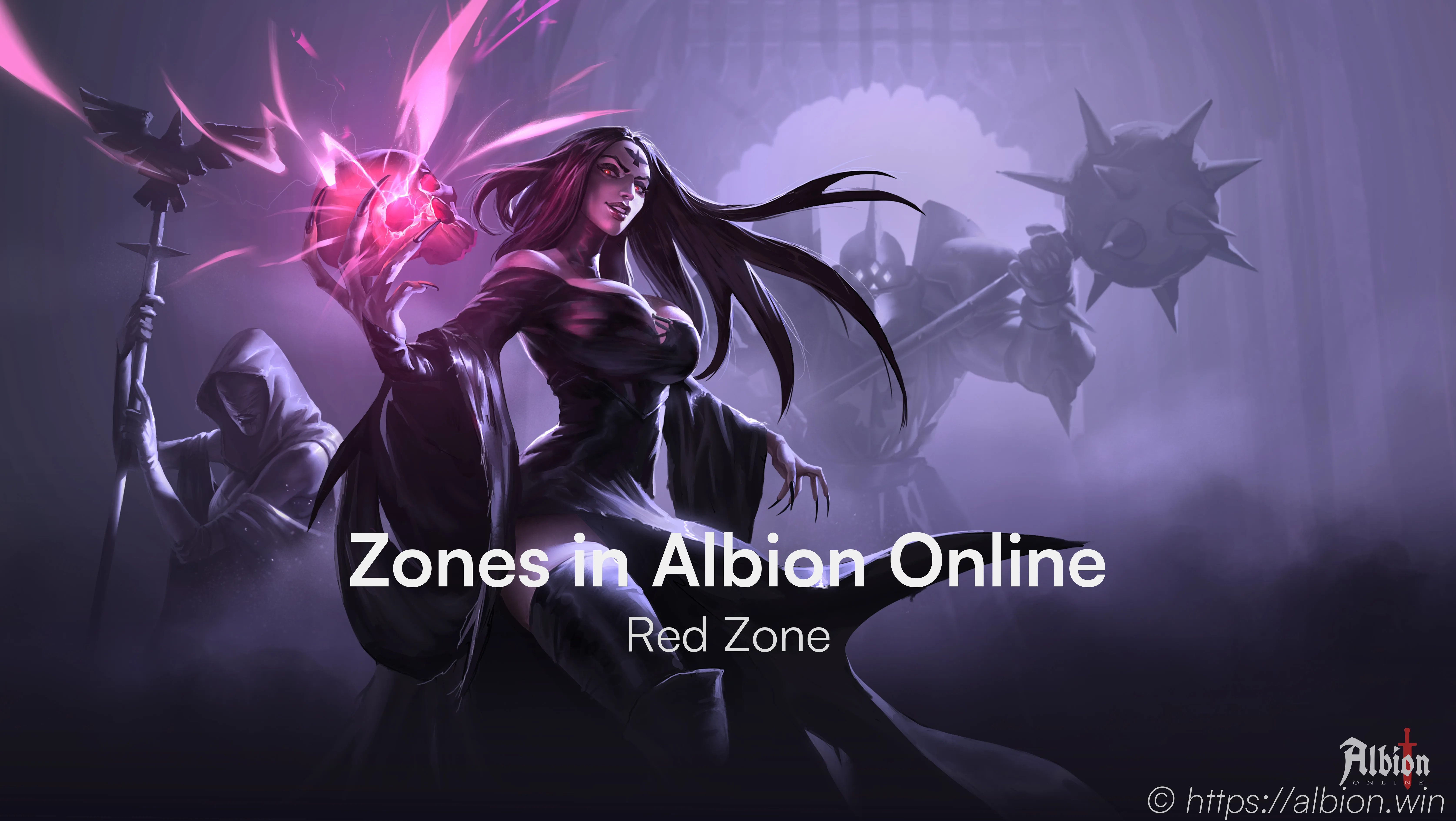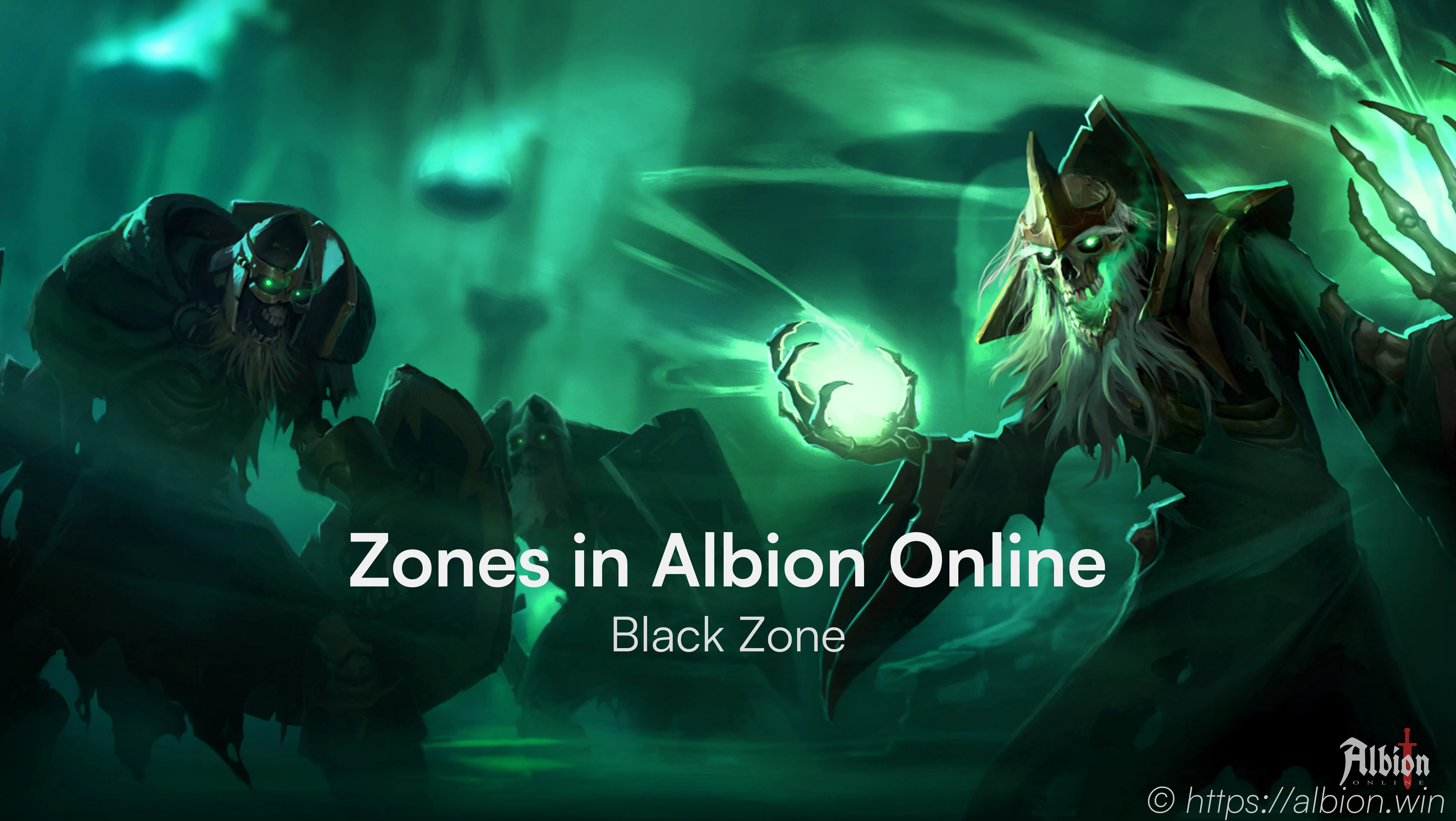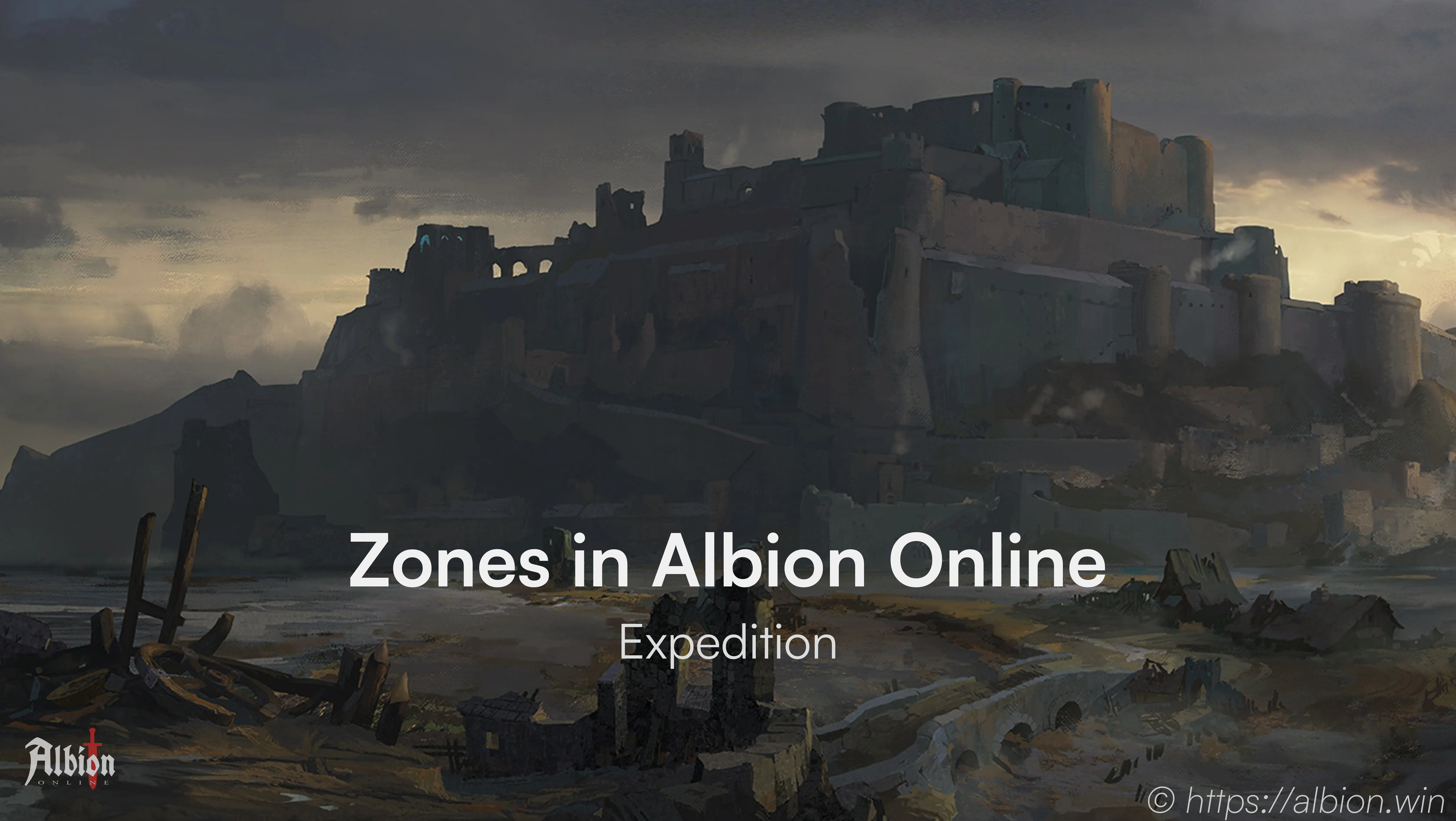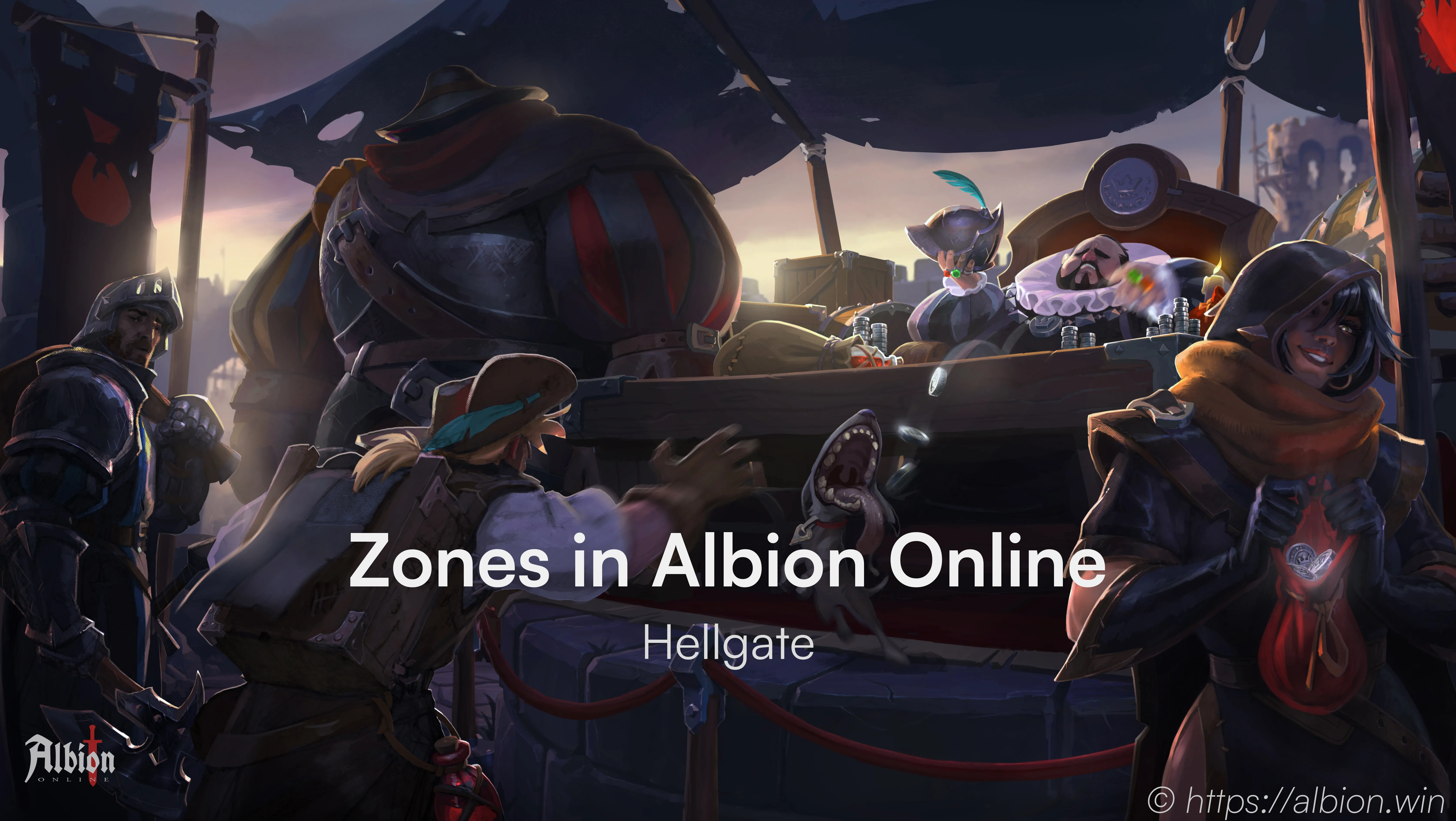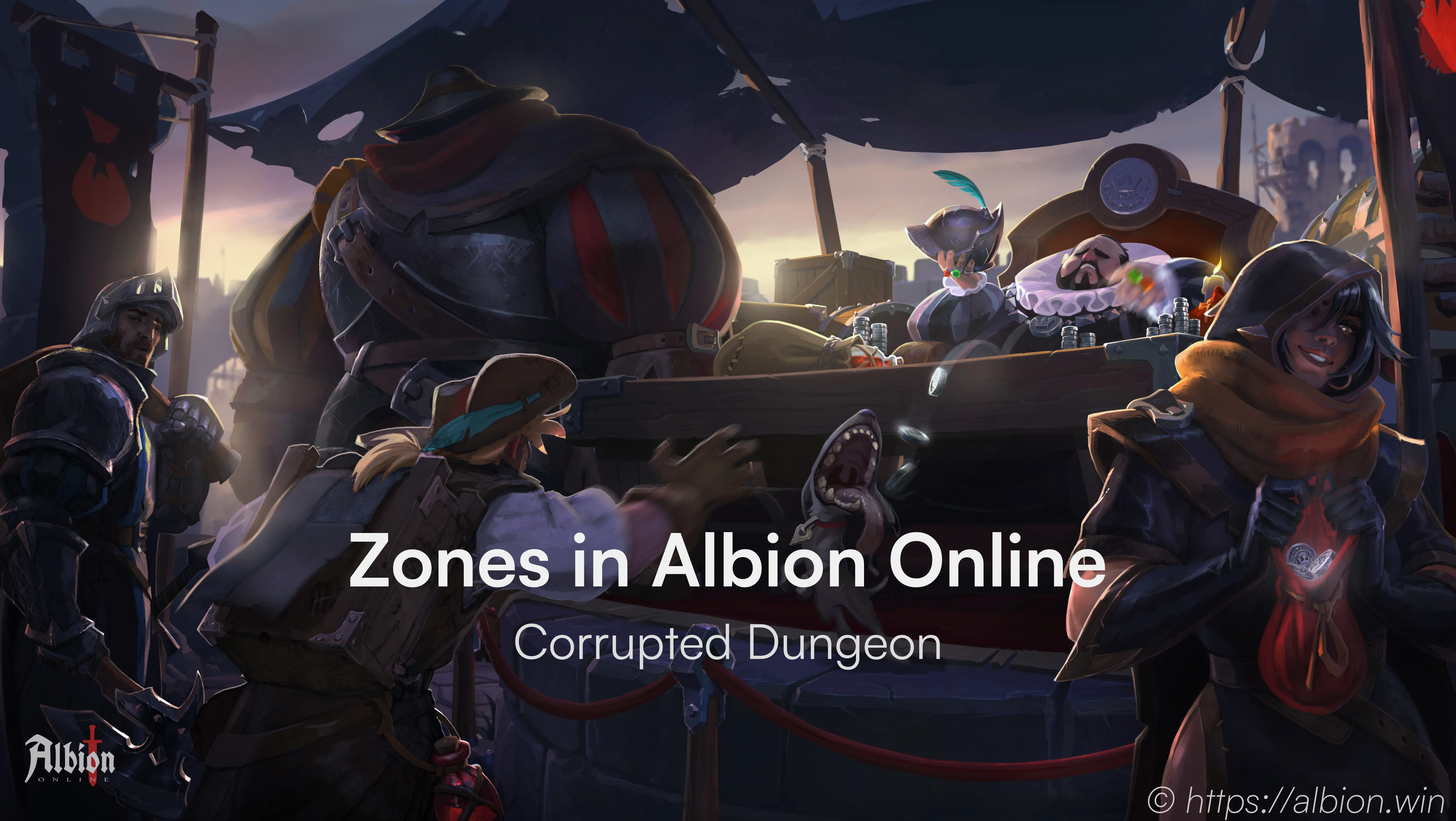In this post you will learn more about the different Zones Albion Online has to offer!
Welcome to the world of Albion Online, where players can explore a vast and dangerous game world filled with various zones and dungeons to test their skills and courage. Each zone offers different risks and rewards, catering to players of all levels and play styles. Here are the various zones you can encounter in Albion Online:
- Blue Zone: A safe zone where players can gather resources, trade, and craft without fear of PvP combat.
- Yellow Zone: A zone with limited PvP combat where players can engage in open-world PvP without risking their equipment.
- Red Zone: A zone where PvP combat is free for all, and players risk losing their equipment upon death.
- Black Zone: A zone where players can find the rarest and most valuable resources in the game but face the highest risk of PvP combat and death.
- Expedition: Solo or group-based dungeon instances where players can earn rewards and fame by completing objectives and fighting bosses.
- Non-lethal Hellgate: A dungeon instance that allows players to engage in 2v2, 5v5 or 10v10 PvP combat without risking equipment.
- Lethal Hellgate: A dungeon instance where players engage in 2v2, 5v5 or 10v10 PvP combat with the risk of losing equipment upon death.
- Hunter Corrupted Dungeon: A solo dungeon where players hunt corrupted creatures for loot and fame. PvP is possible through invasions, but non lethal on Hunter.
- Stalker Corrupted Dungeon: A solo dungeon where players hunt corrupted creatures for loot and fame. PvP is possible through invasions, lethal and full loot.
- Slayer Corrupted Dungeon: A challenging dungeon for experienced players where they fight powerful corrupted creatures. PvP is possible through invasions, lethal and full loot.
Blue Zone
Blue Zones in Albion Online are considered safe zones where players can engage in low-risk activities such as gathering, trading, and crafting. These areas offer a relatively low risk compared to other zones in the game, making them ideal for new players who are still learning the mechanics.
While in blue zones, players can gather resources up to tier four without fear of being attacked by other players. Gathering is the process of harvesting resources from resource nodes in the game world, and players can gather wood, metal, leather, food, and other resources by using specialized gathering tools such as a wood axe or pickaxe.
Players can also engage in trading within blue zones. They can buy and sell goods with other players at marketplaces located in cities or on their own islands. Blue zones are ideal for trading because they are safe and free from the risks associated with red and black zones. Players can build their wealth by trading valuable resources and items, which they can then use to purchase better gear and equipment.
Crafting is another activity that players can engage in blue zones. Crafting is the process of turning raw materials into useful items, weapons, and equipment. Players can craft items by using resources they have gathered or purchased from other players. Blue zones provide a safe environment where players can focus on developing their crafting skills without fear of being attacked.
It’s important to note that while blue zones are generally safe, players who are Faction flagged can still engage in PvP combat in these areas. Deaths while enlisted for a city within the Faction Warfare system in blue zones will knock down the victim, taking 5% durability on all of their equipable items, and respawning them in their nearest faction outpost. Also, being knocked down by mobs in blue zones will cause all equipable items to take a 5% durability loss.
Overall, blue zones are a great starting point for new players in Albion Online. They offer a safe and enjoyable experience, allowing players to develop their skills and gather resources at a relatively low risk. As players gain more experience and confidence, they can venture into yellow, red, and black zones to face greater challenges and reap greater rewards.
Blue Zone features:
- Blue zones are areas within the Royal Continent where PvP is restricted and players cannot engage in full loot PvP.
- Attacking unflagged players while PvP flagged results in reputation loss.
- Blue zones are designed for new and inexperienced players to learn the game mechanics, gather resources, and progress their character.
- Resources up to tier four (IV) can spawn in blue zones.
- Hellgates and Corrupted Dungeons in blue zones are not full loot, but players may still lose their equipment upon death.
- Blue zones offer a relatively safe environment for players to progress their character and learn the game without the constant threat of PvP.
Yellow Zone
Yellow Zones in Albion Online are designated as moderate-risk zones where players can engage in PvP combat, gathering, trading, and other activities. These zones have the highest restrictions next to Blue Zones and offer a level of challenge for players who are looking for more excitement than Blue Zones provide. In Yellow Zones, players can engage in PvP combat by flagging themselves as red or hard-flagged. This will allow them to attack other flagged and non-flagged players. However, attacking unflagged players while red flagged will result in reputation loss.
Players who die as a result of red-flagged PvP combat in Yellow Zones will “knock out” for three minutes and take 5% durability on all their equipable items. Faction flagged players in Yellow Zones follow the same rules as they do in Blue Zones. The number of red-flagged players in the cluster is visible in the bottom right corner below the minimap, and updates every 10 seconds.
Yellow Zones offer a moderate level of risk and reward, making them an excellent starting point for players who want to develop their skills and gear in Albion Online. Resources up to tier five can spawn in Yellow Zones, and Hellgates and Corrupted Dungeons do not result in full loot deaths.
Yellow Zones provide players with the opportunity to experience PvP combat without the high risk of death found in Red and Black Zones. As players become more experienced and confident, they can venture into higher risk zones to reap even greater rewards. Whether you’re a new or experienced player, Yellow Zones offer an exciting and rewarding experience in the world of Albion Online.
List of features in Yellow Zones:
- PvP flagging for red-flagged PvP combat
- Moderate-risk PvP combat, gathering, and trading
- Knockout for three minutes and 5% durability loss on equipable items for deaths in red-flagged PvP combat
- Reputation loss for attacking unflagged players while red-flagged
- Resources up to tier five can spawn in Yellow Zones
- Hellgates and Corrupted Dungeons do not result in full loot deaths.
Red Zone
Red zones in Albion Online are considered the high-risk, high-reward areas of the game, offering some of the toughest challenges and the greatest rewards for experienced players. These zones are known for full loot PvP combat, where players engage in faction warfare and PvP flagging against each other, and deaths resulting from either system can cause players to lose all equipped items and inventory.
Players who enter red zones must be well-equipped and prepared to face other players who are also looking to earn rewards. In addition to PvP combat, red zones offer the opportunity to gather resources and participate in open-world boss fights, which can provide valuable rewards.
It’s important to note that attacking unflagged players while PvP flagged results in reputation loss. And, while the number of red-flagged players in the cluster is visible in the bottom right corner below the minimap, opposing faction flagged players are not displayed.
Resources up to tier six can spawn in red zones, and Hellgates and Corrupted Dungeons in these areas are full loot. It’s worth mentioning that Hellgates in Red zones have a soft item power cap at 1000; item power above 1000 is reduced by 50%, and Guild versus Guild battles have an item power cap of 800 IP. Item power above 800 is reduced by 80%.
List of features in Red Zones:
- Full loot PvP in the open world for both faction warfare and PvP flagging
- Attacking unflagged players while PvP flagged results in reputation loss
- Death results in dropping all of the player’s equipped items and inventory
- High-risk, high-reward activities such as gathering resources, PvP combat, and open-world boss fights
- Ideal for PvP combat because they offer a high level of risk and reward
- Offers challenging open-world bosses for valuable rewards
- Designed for more experienced players who are looking for a greater challenge and higher rewards
- Resources up to tier six can spawn in Red Zones
- Hellgates and Corrupted Dungeons in Red Zones are full loot
- Hellgates in Red Zones have a soft item power cap at 1000; item power above 1000 is reduced by 50%
- Guild versus Guild battles have an item power cap of 800 IP. Item power above 800 is reduced by 80%
- Visible red-flagged player count in the cluster updates every 10 seconds, but opposing faction flagged players are not displayed.
Black Zone
Black zones in Albion Online are high-level areas with full loot PvP automatically enabled, and no flagging system. Players can engage in PvP against each other freely, excluding their guild, alliance, and party without incurring reputation loss. Black zones contain resources up to tier eight and have territories, castles, and castle outposts that generate Season Points. Hellgates and Corrupted Dungeons in black zones are also full loot. Here are some tips for venturing into the Black Zone: use Invisibility Shrines near the exit, stay on the edge of the map when moving to the next territory, avoid traveling on roads, and only bring items and equipment you aren’t worried about losing. The most active and dangerous zones are typically those within 1-2 zones of either a portal zone to the Royal Continent or Small towns.
List of features in Black Zones:
- Black Zones are located in the Outlands, Roads of Avalon, or the Mists.
- Full loot PvP is automatically enabled in Black Zones, and there is no flagging system.
- All players may freely engage in PvP against each other, excluding their guild, alliance, and party without incurring reputation loss.
- Territories, castles, and castle outposts are found in the Black Zones, which all generate Season Points.
- Resources up to Tier 8 can spawn in Black Zones.
- Hellgates and Corrupted Dungeons in Black Zones are full loot.
- Invisibility Shrines can be used near the exit portal to enter the Black Zone from a portal zone.
- Players are advised to stay on the edge of the map when moving between territories, avoid roads, and bring only items and equipment they are not worried about losing.
- Black Zones located within 1-2 zones of either a portal zone to the Royal Continent or small towns are generally considered to be the most active and dangerous.
Expedition
Expeditions in Albion Online are instanced PvE missions that players can access through the Expedition Master NPC in cities. These missions are designed to be relatively short, with a successful run taking around 20 to 30 minutes for group expeditions and 10-15 minutes for solo expeditions. One of the benefits of expeditions is that they are considered fairly safe, as dying during a mission will only cause a transfer to the start of the expedition or the last checkpoint reached without any gear loss, except for a 5% durability loss on your equipment.
There are two types of expeditions available, solo and group. To queue for a group expedition, players must locate the Expedition Master NPC in a nearby city. Depending on the equipment that players have equipped, they will be automatically assigned a role. Defensive role players are expected to tank and draw aggro from mobs and bosses. To achieve this, they wear plate armor and use a tank role weapon such as a 1H Mace. Supportive role players are expected to heal and shield their teammates, so they wear cloth armor and use a healing staff (holy or nature) as their main weapon. Offensive role players deal damage and kill the mobs while avoiding taking damage. Most other weapon types and armor types fit into this category.
Once the group size and tier difficulty have been selected, players will be teleported to an expedition and given a mission to complete. When players are assigned to a specific role, they are locked into that role for the whole duration of the expedition and other players can see their assigned role as well. Completing the mission will cause a portal to appear that brings players back to the city they started from. Solo expeditions give players 60 minutes to complete the mission while group expeditions offer 120 minutes. If players fail to complete the mission within the time limit, they will be teleported back to the city. Leaving an expedition prematurely will put players on a penalty timer before they can start another expedition.
Feature overview:
- Instanced PvE missions accessible through the Expedition Master NPC in cities.
- Relatively short, with successful runs taking 20-30 minutes for group expeditions and 10-15 minutes for solo expeditions.
- Considered fairly safe, with no gear loss upon death, only 5% durability loss on equipment.
- Available in two variants: solo and group.
- Players are automatically assigned a role (defensive, supportive, or offensive) depending on their equipment.
- Once selected, players are locked to their assigned role for the entire expedition.
- Complete the mission and a portal will appear to bring you back to the city you came from.
- Solo expeditions have a 60-minute time limit, while group expeditions have a 120-minute time limit.
- Leaving an expedition prematurely will put you on a penalty timer before you can start another expedition.
Hellgate
Hellgates are accessed through Hellgate Rituals that can be crafted at the Artifact Foundry, looted from mobs or bought. These portals contain small demons, demon bosses, and often another team of players to fight. There are three types of Hellgates - 2v2, 5v5, and 10v10 - and two kinds of each type: non-lethal and lethal. Non-lethal Hellgates have a PvP effect in knockdown and not full loot. In contrast, lethal Hellgates have a PvP effect in death and full loot. Entering a Hellgate requires sufficient base item power and a party size matching the Hellgate type.
The Hellgate Ritual can be used to spawn a certain type of Hellgate in different zones. The roads of Avalon and the Outlands allow all types of maps. In the blue zone (Tier 4), only 2v2 non-lethal Hellgate maps are allowed. The yellow zone (Tier 5) allows all non-lethal Hellgate maps. The red zone (Tier 6+) allows all lethal Hellgate maps. Hellgate Maps can be found as open-world drops or crafted at the Artifact Foundry.
Once inside, there are ten Hellgate layouts, with different features such as chokes, varying altitudes, and vast open areas. Matchmaking is based on the average Hellgate Infamy of the party. The Infamy system is similar to Corrupted Dungeons, and higher Infamy increases rewards earned. Each Hellgate type has its own Infamy progression. Opponents are found based on the average infamy from both teams.
To complete a Hellgate, you need to kill mobs until an Infamy threshold is reached. Depending on the Hellgate layout, you will encounter different mobs and minibosses, and occasionally a boss with huge rewards. If another party enters the Hellgate, all mobs (other than those guarding chests or shrines) will disappear. Once two teams are in the same map, a rising lava mechanic will occur, with lava appearing at the edge of the map and moving towards the center.
If more time passes without a winner, the lava starts encroaching again until only one party is left. Defeating an enemy team causes the lava to disappear and completes the Hellgate, allowing your party to continue onward or return to the Open World. Completing a Hellgate requires a minimum item power requirement and has an IP cap, depending on the type of Hellgate.
Feature list:
- Hellgates are accessed via Hellgate Rituals, which can be crafted, looted or bought
- Three types of Hellgates: 2v2, 5v5, and 10v10
- Two kinds of Hellgates: non-lethal and lethal
- Sufficient base item power and party size required to enter
- Hellgates can be spawned in certain zones using Hellgate Rituals
- Special mechanics include random layouts, infamy system, lava mechanic, and demon/boss mobs
- Completing Hellgates rewards players with chests and an exit portal
- Item power caps vary based on Hellgate type and whether it is non-lethal or lethal
Corrupted Dungeon
Corrupted Dungeons are single-player dungeons found throughout the open world. They offer a mix of PvE and PvP gameplay and require players to cleanse corrupted creatures for Infamy points.
To enter a Corrupted Dungeon, players need to find a Corrupted Dungeon Entrance in the open world. Once inside, players must cleanse corrupted creatures to earn Infamy points. There are three mini-bosses inside that give a large Infamy bonus. When players collect enough Infamy points, the final boss appears and defeating it rewards players with loot and permanently boosts their rewards in Corrupted Dungeons.
Players can also invade or be invaded by others. To invade, players must sign up at a demonic shrine within 45 seconds of entering the dungeon. Once signed up, the game will check for a potential invasion target. If a target is found, the invader is pulled into the target’s dungeon. The defender has the option to rally and fight the invader or try to destroy the demonic shards. If the defender succeeds in destroying enough shards, the invader is banished, and the defender can continue playing their own dungeon. If the invader kills the defender, they gain some of their Infamy and a portion of their dungeon loot.
Corrupted Dungeons offer several special features to add tactics and depth to encounters. NPC positions are marked on the mini-map, and Watcher demons mark any player they encounter on the mini-map for their opponent to see. Additionally, there are many traps and hazards that players need to avoid or use to outsmart and defeat their opponents.
There are three difficulty levels: Hunter, Stalker, and Slayer. Hunter is the easiest, and Slayer is the hardest. The difficulty level determines the difficulty of the mobs, the rewards, and the type of PvP. Hunter is located in safe and yellow zones, Stalker is in red and black zones with full loot PvP, and Slayer is located in red and black zones with full loot PvP and a high Infamy requirement.
Feature overview:
- Single-player dungeons found throughout the open world
- Players choose a difficulty level and begin cleansing corrupted creatures for Infamy points
- Invasions and PvP available, with invaded player given a choice to fight or banish the invader
- Killing another player grants a portion of their Infamy, with higher Infamy levels giving access to higher-level dungeons and better rewards
- Location: found by exploring the open world and finding a Corrupted Dungeon Entrance
- Infamy rankings and rewards permanently boosted by completing dungeons and defeating final boss
- NPCs marked on mini-map, traps and hazards add tactical depth to encounters
- Three difficulty levels: Hunter, Stalker, and Slayer, with differing PvP rules, mob levels, and rewards
- Infamy caps and reductions for bringing high-IP items into lower-level dungeons
